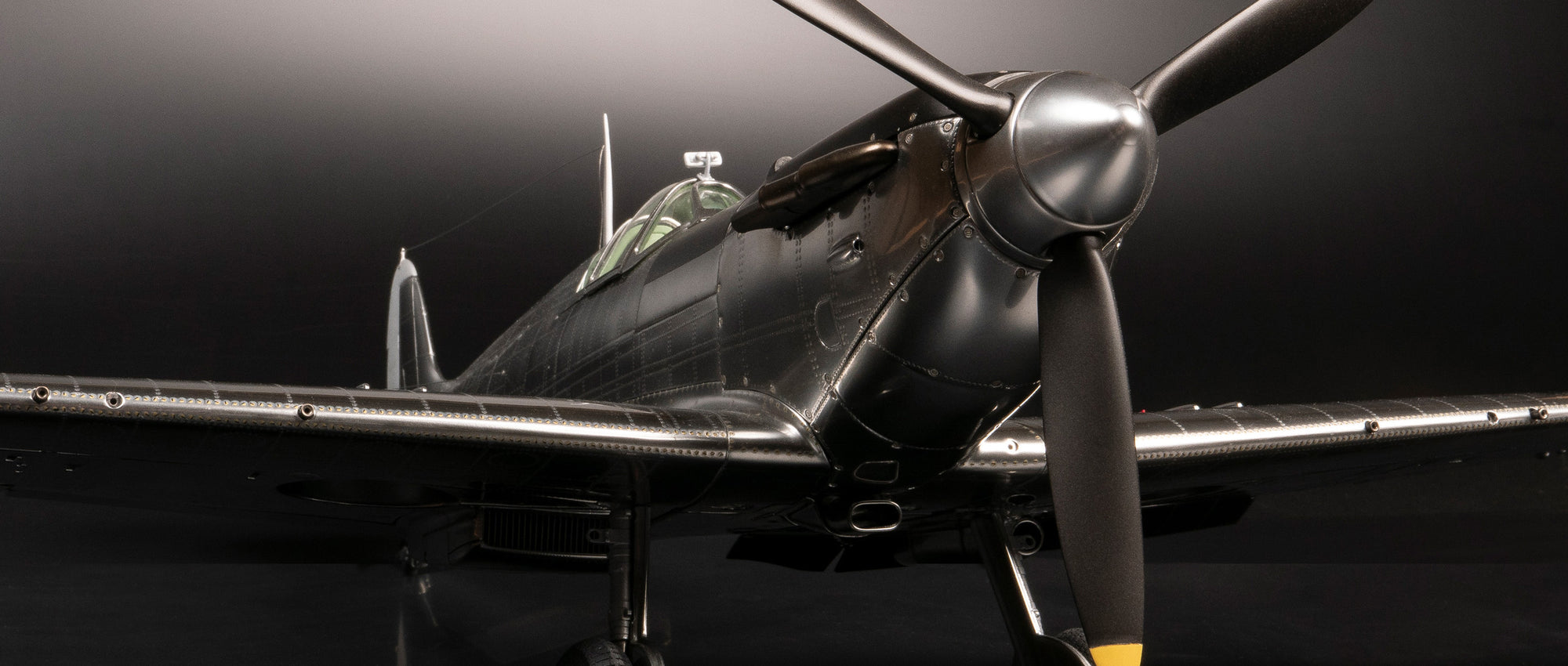Technical Details
- Description
- Scale guide
- Limited edition of 50 models, presented in a striking bare aluminium finish
- Based on the Mk 1a aircraft flown by Geoffrey Wellum of 92 Squadron in September 1940
- Each model hand-built and assembled by a small team of craftsmen
- 1:16 scale model, over 60 centimetres/23 inches long with a wingspan of over 70 centimetres/27 inches wide
- Made using the finest quality materials
- Over 6000 hours to develop the model
- Over 400 hours to build each model
- Thousands of precisely engineered parts: castings, photo-etchings and CNC machined metal components
- Built using original CAD designs developed from an original scan of aircraft in the Battle of Britain Memorial Flight based at Coningsby in Lincolnshire
A beacon of defiance in Britain’s darkest hour, the Supermarine Spitfire stands as the nation’s most iconic World War II fighter. Conceived by Reginald Mitchell of Supermarine Ltd., it was developed in response to a 1934 Air Ministry specification for a high-performance interceptor armed with eight wing-mounted 0.303-inch (7.7mm) machine guns. Its lineage traced directly to Mitchell’s Schneider Trophy racing seaplanes of the 1920s, machines built to chase absolute speed. One such aircraft, the S.6, set a world speed record of 357 mph (574 km/h) in 1929.
From Racing Seaplanes to Frontline Fighter
Mitchell’s approach was more radical than that of the Hawker Hurricane, a design rooted in steel tubing, wood, and fabric and favoured by many RAF commanders of the 1930s. The Spitfire instead employed a stressed-skin aluminium monocoque structure wrapped around a 1,000 hp, 12-cylinder, liquid-cooled Rolls-Royce PV-12 engine, later immortalised as the Merlin. Its defining feature was a graceful elliptical wing with a thin airfoil, which, combined with the Merlin’s efficient supercharging, delivered exceptional performance at high altitude. This advanced construction made the Spitfire both difficult to build and challenging to repair, leading some to question whether it was too sophisticated for wartime realities.
The Spitfire’s eight wing-mounted guns were harmonised to converge at a single point ahead of the aircraft, while pilots were aided by an electric gunsight that projected an orange aiming dot onto the windscreen - an early forerunner of the modern heads-up display.
Into Service - and Mitchell’s Final Legacy
The prototype first flew in March 1935, with the aircraft entering RAF service in July 1938. The first operational Spitfires arrived at No. 19 Squadron at Duxford on 4 August. Tragically, Mitchell did not live to see his creation enter service, succumbing to cancer in June 1937. Even after learning his illness was terminal, he continued to work relentlessly, against medical advice, determined to see the project through.
Early Combat and an Uncertain War
In the early stages of the war, Spitfires were initially held back, with Hurricanes forming the backbone of Fighter Command, though they did see action during the evacuation of Dunkirk. The Spitfire claimed its first victories on 16 October 1939, when aircraft from Nos 602 and 603 Squadrons shot down two Junkers Ju 88 bombers over the Firth of Forth. By the summer of 1940, Germany launched its aerial offensive against Britain. In the wake of the rapid Nazi advance across Europe, many - including influential voices in France and the United States - believed Britain’s position to be untenable. Even with the Spitfire, RAF pilots faced technically capable opponents in overwhelming numbers, and contemporary estimates painted the aircraft as an underdog by almost every measure.
The Battle of Britain
During the Battle of Britain, Spitfires were preferentially tasked with engaging German fighters, while Hurricanes attacked the bombers. Although more Hurricanes were deployed and credited with a greater number of victories, Spitfire squadrons suffered lower losses and achieved a higher victory-to-loss ratio. Its superior high-altitude performance is widely regarded as a critical factor in tipping the balance of the war effort. At the height of the battle, the Luftwaffe committed an average of 1,000 aircraft per day, with one massive raid on London involving more than 1,100 machines - yet time and again they were repelled, with the Spitfire at the forefront.
Evolution and Global Service
Most Spitfires flown during the Battle of Britain were Mk I variants, though many were replaced by the Mk II by the end of 1940. Thereafter, the Spitfire supplanted the Hurricane as the primary fighter of RAF Fighter Command and served across the European, Mediterranean, Pacific, and South-East Asian theatres. Mk I Spitfires were also supplied to allied nations including France, Portugal, and Turkey. In total, 1,533 Mk I aircraft were built by Supermarine, with a further 50 produced by Westland Aircraft. All Mk I Spitfires were officially declared obsolete by February 1945.
The Spitfire’s Legacy
The Spitfire’s influence extended far beyond the battlefield. Its elegant form and hard-won victories were woven into the fabric of Britain’s wartime identity, becoming a potent symbol of resistance and resilience. Widely used in propaganda to rally public morale and project confidence at home and abroad, it stood as visible proof that Britain could fight back. In time, the Spitfire transcended its role as a fighter aircraft, enduring as an icon of courage, ingenuity, and national survival.
A Faithful Replica
This fine Amalgam scale model is a faithful 1:16 scale reproduction of the Supermarine Spitfire Mk 1a aircraft flown by Geoffrey Wellum of 92 Squadron in September 1940. It represents one of the most accurate and highly detailed Spitfire models ever produced at this scale. Every minute detail of the aircraft has been meticulously recreated, from the thousands of individual rivets to the finely detailed cockpit and the upper structure of the Rolls Royce Merlin engine. As with all Amalgam models, it is the result of a seamless fusion of art, technology and dedication, combining original digital scan data and extensive historical research with master-level sculpting and finishing to create a model virtually indistinguishable from the real aircraft in photographs. The model has been developed using extremely precise digital scan data gathered from Battle of Britain Memorial Flight aircraft based at RAF Coningsby in Lincolnshire. It is presented in a striking ‘bare metal’ finish, allowing every aspect of the Spitfire’s refined engineering to be fully appreciated. Each Supermarine Spitfire is hand-built to order, so please contact our sales team to discuss bespoke specifications or individual requirements.
The Mk 1a Supermarine Spitfire is limited to just 50 editions.
Please note that, due to the large size of this piece and complexities of shipping, additional costs will be calculated and billed separately based on delivery location.
Pre-order
Bespoke
In order for us to create your bespoke model, you will need to choose 4 extra options. Paint colour, interior colour, wheel style and caliper colour.
Please complete the form and a member of our Sales Team will contact you.
Contact Us
Please contact us for more information about ordering this model.






